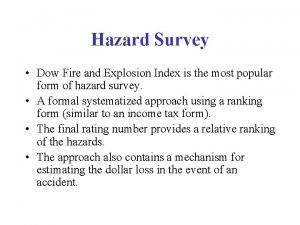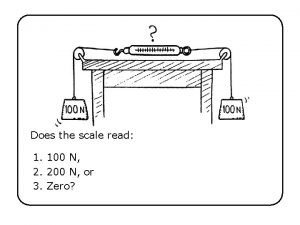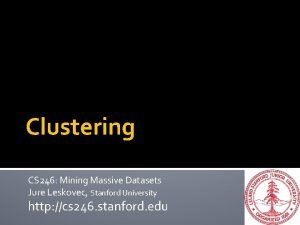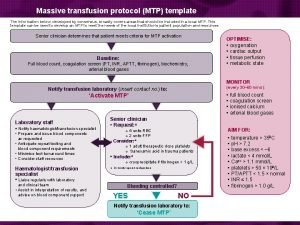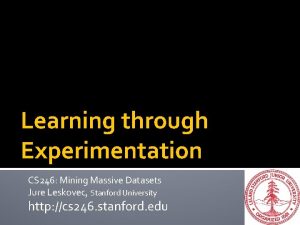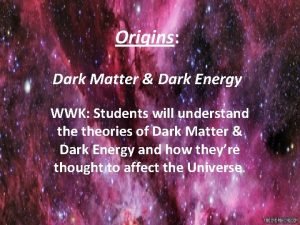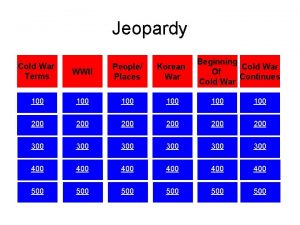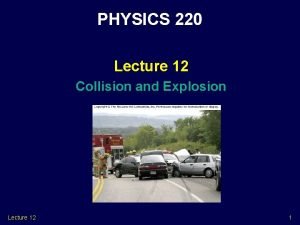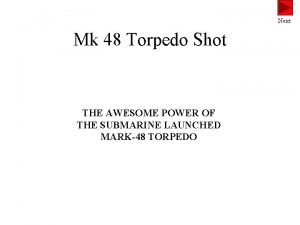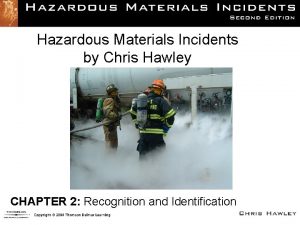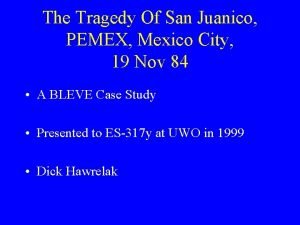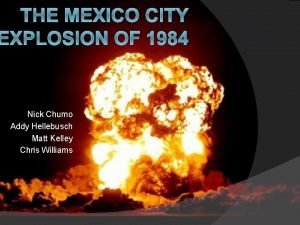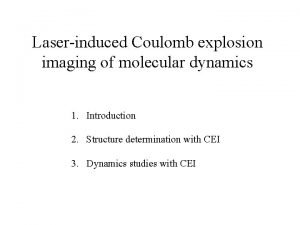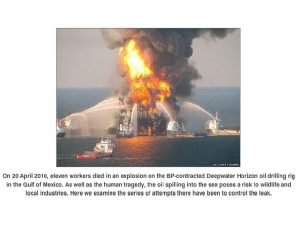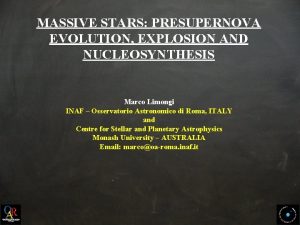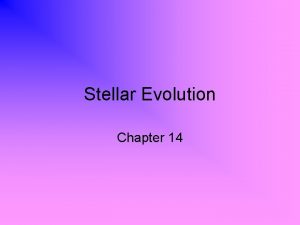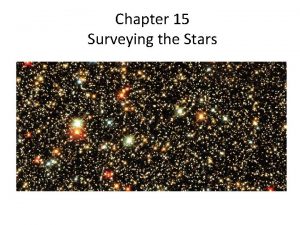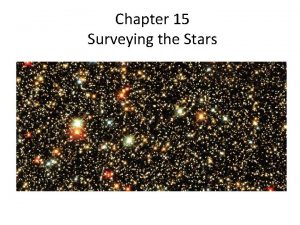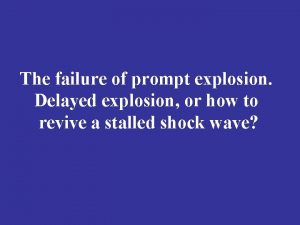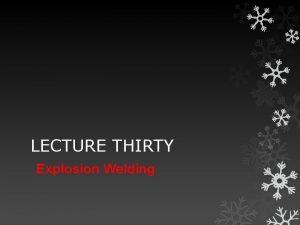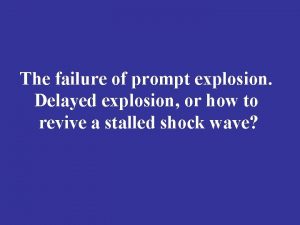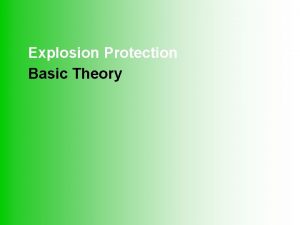The Evolution and Explosion of Massive Stars Cornell



























































- Slides: 59

The Evolution and Explosion of Massive Stars Cornell Physics Colloquium, February 25, 2002 see also Reviews of Modern Physics, S. E. Woosley, A. Heger, and T. A. Weaver, in press (2002) http: //www. supersci. org

Supernovae: Make brilliant fireworks Produce most of the heavy elements Leave behind exotic neutron stars and black holes Stir the interstellar and intergalactic media

(Massive) stars are gravitationally confined thermonuclear reactors.

For a star supported by ideal gas pressure, density scales as temperature cubed: For a star of constant mass supported by ideal gas pressure, as contraction raises the density the temperature will also increase as the cube root of the density. For a given temperature, stars of lower mass will have higher density.

In fact, for stars lighter than about 8 solar masses the central regions reach a density where the star can be supported by the quantum mechanical crowding of the electrons (degeneracy pressure), before the ignition temperature of carbon (8 x 108 K) Such stars, e. g. , the sun, end their lives as white dwarf stars after ejecting part of their outer layers as a planetary nebula.

For more massive stars though. . .


Neutrino Losses The evolution of the interior of massive stars after helium burning (i. e. , during carbon, neon, oxygen, and silicon burning) is governed by pair neutrino losses. These losses are highly sensitive to the temperature. Itoh et al 1996, Ap. JS, 102, 411, see also Beaudet, Petrosian, & Salpeter 1967, Ap. J, 147, 122

The advanced burning stages of massive stars occur in a state of nearly balanced power with energy generation from nuclear fusion balancing neutrino losses to pair annihilation Assuming since the main sequence Such a plot yields the correct burning temperature to good accuracy

Burning Stages in the Life of a Massive Star

The three greatest uncertainties in modeling the presupernova evolution of massive stars are: • Convection and convective boundaries • Rotation • Mass loss (especially the metallicity dependence)

The advanced burning stages are characterized by multiple phases of core and shell burning. The nature and number of such phases varies with the mass of the star. Each shell burning episode affects the distribution of entropy inside the helium core and the final state of the star (e. g. , iron core mass) can be non-monotonic and, to some extent, chaotic. Neutrino losses are higher and the central carbon abundance lower in stars of higher mass.

This movies shows the variation of the convective structure post-helium burning as the mass of the main sequence star is varied. For this choice of 12 C(a, g)16 O rate, carbon ceases to generate sufficient heat to cause central convection in stars above about 20 solar masses. convective and nuclear time scales comparable beyond here

Kuhlen, Woosley, and Glatzmaier are exploring the physics of stellar convection using 3 D anelastic hydrodynamics. The model shown is a 15 solar mass star half way through hydrogen burning. For now the models are not rotating, but the code includes rotation and B-fields. (Previously used to simulate the Earth’s dynamo).

Evolution Including Rotation Heger, Langer, and Woosley (2000), Ap. J, 528, 368

note models “b” (with B-fields) and “e” (without) Heger, Woosley, & Spruit, in prep. for Ap. J Spruit, (2001), A&A, 381, 923

Uncertainties in key reaction rates affect not only the nucleosynthesis but the explosion itself

With each progressive burning stage the central entropy decreases. Red giant formation leads to an increased entropy in the outer hydrogen envelope. The decrease in central entropy is accompanied by an increase in degeneracy so that in its later (post-carbon) burning stages the idea of a Chandrasekhar Mass has some meaning. Ultimately the iron core that forms is not too dissimilar to the Chandrasekhar Mass but with corrections for: a) composition b) thermal content c) Coulomb effects d) finite boundary pressure

Weak interactions are important: beta-equilibrium lost by core collapse Dynamic beta equilibrium near end of Si shell burning positron decay negligible Si convective core burning

O Presupernova composition structure He Fe Stars of higher mass have larger helium cores and thicker shells of heavy elements outside an iron core of relatively constant mass. O Fe He Note that due to mass loss the 15 and 25 solar mass main sequence stars have almost the same mass whne they die.

The helium core is that part of the star that has burned up all its hydrogen when the star finally dies. The CO core is the part that has burned up all the helium. Low metallicity stars can have larger helium and CO cores when they die because the mass loss is reduced. The maximum helium core mass for a single star of solar metallicity is about 12 solar masses.

Gravitational Binding Energy of the Presupernova Star solar low Z This is just the binding energy outside the iron core. Bigger stars are more tightly bound and will be harder to explode. The effect is more pronounced in metal-deficient stars.

range of iron core masses The iron core mass is a (nucleosynthetic) lower limit to the baryonic mass of the neutron star. A large entropy jump characterizes the base of the oxygen shell and may provide a natural location for the mass cut. Naively the baryonic mass of the remnant may be between these two – but this is very crude and ignores fall back. Above some remnant mass (1, 7? 2. 2? ) a black hole will result. For the most abundant supernovae (10 to 20 solar masses) the range of iron core masses is 1. 2 to 1. 55 solar masses. For the oxygen shell it is 1. 3 to 1. 7. From these numbers subtract about 15% for neutrino losses. Across all masses the iron core varies only from 1. 2 to 1. 65 solar masses.

Thorsett and Chakrabarty, (1999), Ap. J, 512, 288 Observations indicate a narrow range of gravitational masses of 1. 3 – 1. 4 solar masses. Effects of binary membership? Maximum neutron star mass (Bethe-Brown)? Small number statistics?

Owing to a combination of neutrino losses, electron capture, and photodisintegration, the iron core collapses. (note by the way the low value of Ye and its large variation; the zero entropy Chandrasekhar Mass would be far less than 1. 4 solar masses. The agreement of average neutron star masses with this value is a coincidence. )

Baade and Zwicky, Proceedings of the National Academy of Sciences, (1934) “With all reserve we advance the view that a supernova represents the transition of an ordinary star into a neutron star consisting mainly of neutrons. Such a star may possess a very small radius and an extremely high density. As neutrons can be packed much more closely than ordinary nuclei and electrons, the gravitational packing energy in a cold neutron star may become very large, and under certain conditions, may far exceed the ordinary nuclear packing fractions. . . ”

The explosion is mediated by neutrino energy transport. . Colgate and White, (1966), Ap. J, 143, 626 see also Arnett, (1966), Canadian J Phys, 44, 2553 Wilson, (1971), Ap. J, 163, 209

But there were fundamental problems in the 1960’s and early 1970’s that precluded a physically complete description • Lack of realistic progenitor models • Neglect of weak neutral currents • Uncertainty in the equation of state at super-nuclear densities • Inability to do multi-dimensional models

BBAL 1979 • The explosion was low entropy • Heat capacity of excited states kept temperature low • Collapse continues to nuclear density and beyond • Bounce on the nuclear repulsive force • Possible strong hydrodynamic explosion • Entropy an important concept


Death of the shock in a star of 15 solar masses. The shock is born at the edge of the “homologous core” near 0. 7 solar masses. Initially the bounce gives it positive kinetic energy, but for each 0. 1 solar masses it traverses and photodisintegrates about 1051 erg of energy is lost. Additional energy is lost as the shock moves to low densities, gm cm-3, to neutrinos. After about 10 ms the once powerful shock has stagnated and become an accretion shock.

* * See also conference proceedings by Wilson (1982)

Wilson 20 M-sun Myra and Burrows, (1990), Ap. J, 364, 222 Neutrino luminosities of order 1052. 5 are maintained for several seconds after an initial burst from shock break out. At late times the luminosities in each flavor are comparable though the mu and tau neutrinos are hotter than the electron neutrinos. Woosley et al. (1994), Ap. J, , 433, 229


Neutrinosphere Velocity gain radius Infall Accretion Shock Inside the shock, matter is in approximate hydrostatic equilibrium. Inside the gain radius there is net energy loss to neutrinos. Outside there is net energy gain from neutrino deposition. At any one time there is about 0. 1 solar masses in the gain region absorbing a few percent of the neutrino luminosity.

Herant and Woosley, 1995. 15 solar mass star. successful explosion. (see also Herant, Benz, & Colgate (1992), Ap. J, 395, 642)

Beneficial Aspects of Convection • Increased luminosity from beneath the neutrinosphere • Cooling of the gain radius and increased neutrino absorption • Transport of energy to regions far from the neutrinosphere (i. e. , to where the shock is) Also Helpful • Decline in the accretion rate and accompanying ram pressure as time passes • A shock that stalls at a large radius • Accretion sustaining a high neutrino luminosity as time passes (able to continue at some angles in multi-D calculations even as the explosion develops).

Burrows, Hayes, and Fryxell, (1995), Ap. J, 450, 830 15 Solar masses – exploded with an energy of order 1051 erg. see also Janka and Mueller, (1996), A&A, 306, 167

At 408 ms, KE = 0. 42 foe, stored dissociation energy is 0. 38 foe, and the total explosion energy is still growing at 4. 4 foe/s


Mezzacappa et al. (1998), Ap. J, 495, 911. Using 15 solar mass progenitor WW 95. Run for 500 ms. 1 D flux limited multi-group neutrino transport coupled to 2 D hydro. No explosion.

Generic Problems with “Successful” Explosions • Leave neutron star masses that are too low – about 1. 1 solar masses • Eject too much neutron-rich material – about 0. 1 solar masses of Ye below 0. 45. Sr, Y, Zr • May be too energetic perhaps because. . • Neutrino transport not handled well in multi-D models • Most models 2 D so far; need 3 D • May be under-resolved

In nuclear statistical equilibrium the abundances of nuclei are very sensitive to the degree of neutronization as measured by Ye. For Ye below 0. 45, the abundant species in nse are very rare in nature. Ye = 0. 45 Hartmann, Woosley, and El Eid (1985), Ap. J, 297, 837

First three-dimensional calculation of a core-collapse 15 solar mass supernova. This figure shows the iso-velocity contours (1000 km/s) 60 ms after core bounce in a collapsing massive star. Calculated by Fryer and Warren at LANL using SPH (300, 000 particles). The box is 1000 km across. Resolution is poor and the neutrinos were treated artificially (trapped or freely streaming, no gray region), but such calculations will be used to guide our further code development. 300, 000 particles 1. 15 Msun remnant 2. 9 foe 1, 000 “ 1. 15 “ 2. 8 foe – 600, 000 particles in convection zone 3, 000 “ in progress

Conclusions here • There is controversy here that will not be settled by democracy, but by better calculations that a) Include good to excellent multi-angle multi-group neutrino transport b) Are three dimensional these will be computationally intensive but can be done. • There needs to be better cross comparison among the groups doing the problem a) Running the same progenitors b) Using as much as possible the same physics (as well as their version of the “best” physics in the different codes c) Talking to each other • My own --- Probably there is nothing wrong with the basic model, but with the codes.



25 Solar Masses; Rauscher et al. (2002), Ap. J, submitted 300 such models currently being calculated. Heger & Woosley



As the expanding helium core runs into the massive, but low density hydrogen envelope, the shock at its boundary decelerates. The deceleration is in opposition to the radially decreasing density gradient of the supernova. Rayleigh-Taylor instability occurs. The calculation at the right (Herant and Woosley, Ap. J, 1995) shows a 60 degree wedge of a 15 solar mass supernova modeled using SPH and 20, 000 particles. At 9 hours and 36 hours, the growth of the non-linear RT instability is apparent. Red is hydrogen, yellow is helium, green is oxygen, and blue is iron. Radius is in solar radii.

15 Solar Mass Supernova – Herant and Woosley (1994), Ap. J, 425, 814 H He Ni O

Diagnosing an explosion Kifonidis et al. (2001), Ap. JL, 531, 123 Left - Cas-A SNR as seen by the Chandra Observatory Aug. 19, 1999 The red material on the left outer edge is enriched in iron. The greenish-white region is enriched in silicon. Why are elements made in the middle on the outside? Right - 2 D simulation of explosion and mixing in a massive star - Kifonidis et al, Max Planck Institut fuer Astrophysik

Fallback S 35 B Woosley and Weaver, (1995), Ap. JS, 101, 181 *

Fall back and mixing together, plus uncertainties in the explosion energy can really complicate the calculation of nucleosynthesis.

r-Process Site #1: The Neutrino-powered Wind * Anti-neutrinos are "hotter" than the neutrinos, thus weak equilibrium implies an appreciable neutron excess, typically 60% neutrons, 40% protons * favored T 9 = 5 – 10 T 9 = 3 - 5 T 9 = 1 - 2 Nucleonic wind, 1 - 10 seconds Duncan, Shapiro, & Wasserman (1986), Ap. J, 309, 141 Woosley et al. (1994), Ap. J, 433, 229

So far the necessary high entropy and short time scale for the r-process is not achieved in realistic models for neutron stars (though small radius helps). Takahashi, Witti, & Janka A&A, (1994), 286, 857 Qian & Woosley, Ap. J, (1996), 471, 331 For typical time scales need entropies > 300. Thompson, Burrows, and Meyer, (2001), Ap. J, 562, 887 blue lines show contraction from about 20 km then evolution at constant R = 10 km as the luminosity declines.

The light curves and spectra of Type II supernovae are relatively insensitive to the uncertainties surrounding the explosion mechanism – though they do depend on mixing and the amount of 56 Ni that is ejected. Eastman, Pinto, & Woosley Current models work well

Conclusions • Models for supernova explosions based on neutrino energy transport appear to work qualitatively. Exact agreement with observations - if possible - will require a new generation of codes and computers. • Similarly, presupernova evolution is qualitatively understood but there remain important uncertainties with respect to convective boundary layers, the effects of rotation and redistribution of angular momentum, mass loss, and the reaction rate for 12 C(ag)16 O • There also remain a number of unresolved problems in supernova physics including: a) the origin of neutron star “kicks”; b) why some supernovae appear to be deformed; c) the relation between supernovae and gamma-ray bursts; d) the site of the r-process; and more. . .
 Life cycle of stars project
Life cycle of stars project There are millions of stars in the space
There are millions of stars in the space Chapter 15 furniture styles and construction answer key
Chapter 15 furniture styles and construction answer key Massive comparative and superlative
Massive comparative and superlative Explosion index
Explosion index There once was a man from china
There once was a man from china Massive igneous rock from which tors develop
Massive igneous rock from which tors develop Seabed massive sulphides (sms)
Seabed massive sulphides (sms) Massive transformation purpose
Massive transformation purpose Massive transfusion protocol
Massive transfusion protocol Arnold strongman and suzie small each pull
Arnold strongman and suzie small each pull Mining massive datasets
Mining massive datasets Massive transfusion complication
Massive transfusion complication Blood transfusion allergic reaction
Blood transfusion allergic reaction Ariel kleiner
Ariel kleiner Cs246 mining massive data sets
Cs246 mining massive data sets Massive hemothorax
Massive hemothorax Tension pneumothorax triad
Tension pneumothorax triad Massive wood chipper
Massive wood chipper Hémiplégie massive proportionnelle
Hémiplégie massive proportionnelle A small sports car collides head on with a massive truck
A small sports car collides head on with a massive truck Mining of massive datasets solution
Mining of massive datasets solution Massive transfusion protocol template
Massive transfusion protocol template Stanford mining massive datasets
Stanford mining massive datasets Massive io
Massive io Grades of splenomegaly
Grades of splenomegaly Massive compact halo objects
Massive compact halo objects Define emesis
Define emesis Massive transfusion protocol template
Massive transfusion protocol template Massive blood transfusion complications
Massive blood transfusion complications Why did stalin want to create a “buffer zone”?
Why did stalin want to create a “buffer zone”? What is mooc
What is mooc Massive calcareous mounds formed by cyanobacteria
Massive calcareous mounds formed by cyanobacteria Philip larkin the explosion
Philip larkin the explosion Famous new york street candy bar
Famous new york street candy bar Evangelism explosion outline
Evangelism explosion outline Population explosion definition
Population explosion definition Elastic and inelastic collision
Elastic and inelastic collision Torpedo 48 shots
Torpedo 48 shots Options diamond thinking routine
Options diamond thinking routine Dmc explosion welding
Dmc explosion welding Mass explosion hazard placard
Mass explosion hazard placard Georg grosz explosion
Georg grosz explosion Population growth factors
Population growth factors Four spiritual laws evangelism method
Four spiritual laws evangelism method Diagrama de explosion
Diagrama de explosion Mass explosion hazard sign
Mass explosion hazard sign Kendall truitt
Kendall truitt Pemex san juanico
Pemex san juanico Population explosion
Population explosion Bleve mexico city 1984
Bleve mexico city 1984 Texas tech chemistry department
Texas tech chemistry department Conceivable in a sentence
Conceivable in a sentence Overpopulation psa
Overpopulation psa During a goal line stand a 75 kg
During a goal line stand a 75 kg Dinamics
Dinamics Oil rig explosion
Oil rig explosion Oil rig explosion
Oil rig explosion Crisis communication skills
Crisis communication skills Explosion hazard
Explosion hazard




